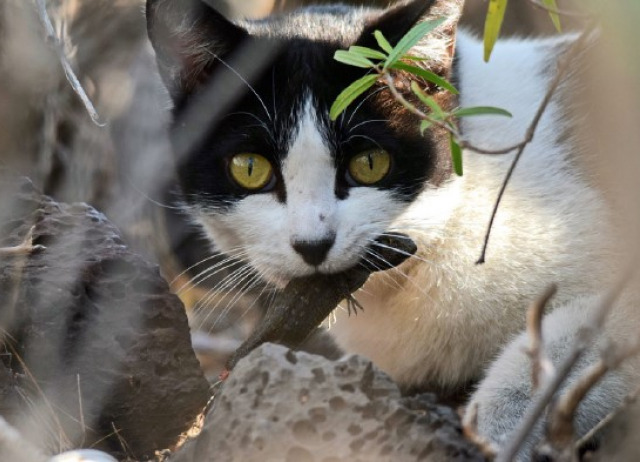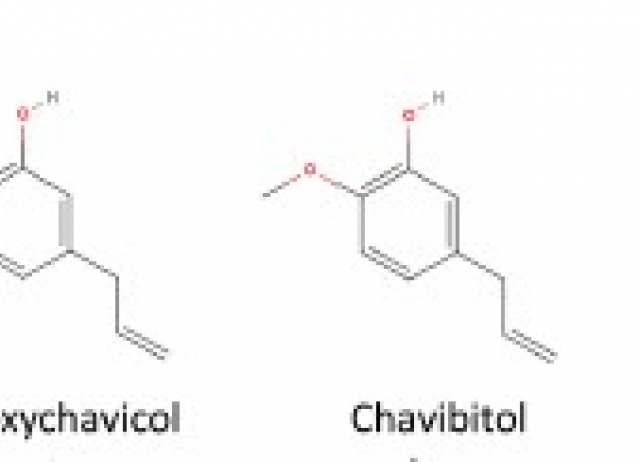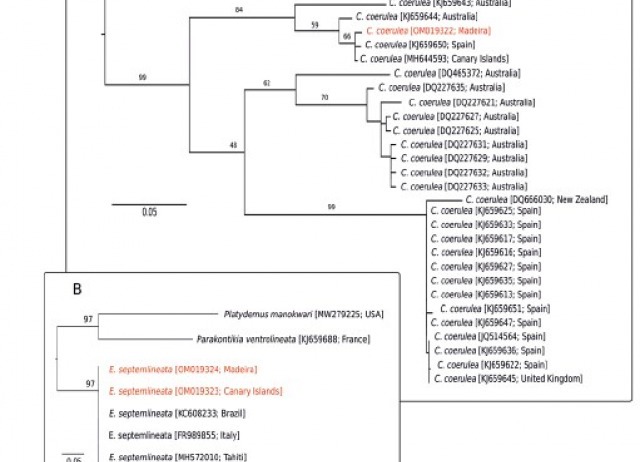
Emerging laws must not protect stray cats and their impacts
Our moral circles—that is, the entities believed as worthy of moral concern and thus deserving moral considerations—have historically expanded beyond humans to include also nonhuman beings (Crimston et al., 2018). As a result, various emerging legal instruments around the world have been granting rights to animals. However, the inclusion of animals within moral circles is subjected to important biases, with a preference for charismatic, familiar, and beautiful vertebrates (Klebl et al., 2021). We argue that legal instruments embracing such biases may jeopardize biodiversity conservation.
Carrete, Martina; Clavero, Miguel; Arrondo, Eneko; Traveset, Anna; Bernardo-Madrid, Rubén; Vilà, Montserrat; Blas, Julio; Nogales, Manuel; Delibes, Miguel; García-Rodríguez, Alberto; Hernández-Brito, Dailos; Romero-Vidal, Pedro; Tella, José L.
ML-J-DP4: An Integrated Quantum Mechanics-Machine Learning Approach for Ultrafast NMR Structural Elucidation
A new tool, ML-J-DP4, provides an efficient and accurate method for determining the most likely structure of complex molecules within minutes using standard computational resources. The workflow involves combining fast Karplus-type J calculations with NMR chemical shifts predictions at the cheapest HF/STO-3G level enhanced using machine learning (ML), all embedded in the J-DP4 formalism. Our ML provides accurate predictions, which compare favorably alongside with other ML methods.
Yi-Hsuan Tsai; Amichetti, Milagros; Zanardi, María Marta; Grimson, Rafael; Hernández Daranas, Antonio; Sarotti, Ariel M.
Betelvine (Piper betle L.): A comprehensive insight into its ethnopharmacology, phytochemistry, and pharmacological, biomedical and therapeutic attributes
Piper betle L. (synonym: Piper betel Blanco), or betel vine, an economically and medicinally important cash crop, belongs to the family Piperaceae, often known as the green gold. The plant can be found all over the world and is cultivatedprimarily in South East Asian countries for its beautiful glossy heart-shaped leaves, which are chewed or consumed as betelquidand widely used in Chinese and Indian folk medicine, as carminative, stimulant,astringent, against parasitic worms, conjunctivitis, rheumatism, wound, etc., andis also used for religious purposes. Hydroxychavicol is the most important bioactive compound among the wide range of phytoconstituents found in essential oil and extracts. The pharmacological attributes of P. betle are antiproliferation, anticancer, neuropharmacological, analgesic, antioxidant, antiulcerogenic, hepatoprotective, antifertility, antibacterial, antifungal and many more. Immense attention has been paid to nanoformulations and their applications. The application of P. betle did not show cytotoxicity in preclinical experiments, suggesting that it could serve as a promising therapeutic candidate for different diseases. The present review comprehensively summarizes the botanical description, geographical distribution, economic value and cultivation, ethnobotanical uses, preclinical pharmacological properties with insights of toxicological, clinical efficacy, and safety of P. betle. The findings suggest that P. betle represents an orally active and safe natural agent that exhibits great therapeutic potential for managing various human medical conditions. However, further research is needed to elucidate its underlying molecular mechanisms of action, clinical aspects, structure–activity relationships, bioavailability and synergistic interactions with other drugs.
Biswas, Protha; Anand, Uttpal; Chatterjee, Suchismita (Saha); Kant, Nishi; Mishra, Tulika; Masih, Harison; Bar, Ananya; Kumar Pandey, Devendra; Kumar Jha, Niraj; Majumder, Madhumita; Das, Neela; Gadekar, Vijaykumar Shivaji; Shekhawat, Mahipal S.; Kumar, Manoj; Radha; Proćków, Jarosław; Pérez de la Lastra, José M.; Dey, Abhijit
Unveiling the nature of a miniature world: a horizon scan of fundamental questions in bryology
Introduction. Half a century since the creation of the International Association of Bryologists, we carried out a review to identify outstanding challenges and future perspectives in bryology. Specifically, we have identified 50 fundamental questions that are critical in advancing the discipline. Methods. We have adapted a deep-rooted methodology of horizon scanning to identify key research foci. An initial pool of 258 questions was prepared by a multidisciplinary and international working group of 32 bryologists. A series of online surveys completed by a broader community of researchers in bryology, followed by quality-control steps implemented by the working group, were used to create a list of top-priority questions. This final list was restricted to 50 questions with a broad conceptual scope and answerable through realistic research approaches. Key results. The top list of 50 fundamental questions was organised into four general topics: Bryophyte Biodiversity and Biogeography; Bryophyte Ecology, Physiology and Reproductive Biology; Bryophyte Conservation and Management; and Bryophyte Evolution and Systematics. These topics included 9, 19, 14 and 8 questions, respectively. Conclusions. Although many of the research challenges identified are not newly conceived, our horizon-scanning exercise has established a significant foundation for future bryological research. We suggest analytical and conceptual strategies and novel developments for potential use in advancing the research agenda for bryology.
Patiño, Jairo; Bisang, Irene; Goffinet, Bernard; Hedenäs, Lars; McDaniel, Stuart; Pressel, Silvia; Stech, Michael; Ah-Pengi, Claudine; Bergamini, Ariel; Caners, Richard T.; Cargill, Christine; Cronberg, Nils; Duckett, Jeffrey; Eppley, Sarah; Fenton, Nicole J.; Fisher, Kirsten; González- Mancebo, Juana; Hasebe, Mitsuyasu; Heinrichs, Jochen; Hylander, Kristoffer; Ignatov, Michael S.; Martínez-Abaigar, Javier; Medina, Nagore G.; Medina, Rafael; Quandty, Dietmar; Rensing, Stefan A.; Renzagliaaa, Karen; Rennerab, Matthew; Ros, Rosa M.; Schäfer-Verwimp, Alfons; Villarreal, Juan Carlos; Vanderpoorten, Alain
DNA barcoding reveals new records of invasive terrestrial flatworms (Platyhelminthes, Tricladida, Geoplanidae) in the Macaronesian region
Oceanic islands harbour a limited richness of native land planarians, likely explained in large part by their inability to survive long periods of immersion in salt water (Winsor et al. 2004). Instead, most land planarians on islands are the result of introductions (e.g. Justine et al. 2018a; b; Lago-Barcia et al. 2020; Suárez et al. 2018; Winsor et al. 2004), likely due to the global trade of plants, as planarians can be inadvertently transported in the humid soil of pots (Álvarez-Presas et al. 2014; Winsor et al. 2004). Planarians are generalist predators (Sluys 1999) and a potential threat for native invertebrate fauna. Thus, the group has become of interest with regard to understanding the expansions of species distributions into non-native areas. We report here the presence of three invasive land planarian species within oceanic islands of the Macaronesian region: Obama nungara Carbayo, (Carbayo et al. 2016) (new for the Canary Islands), Caenoplana coerulea (Moseley 1877) (new for Madeira) and Endeavouria septemlineata (Hyman 1939) (new for the Canary Islands and Madeira).
Suárez, Daniel; Pedrianes, Juan Ramón; Andújar, Carmelo.
Certification of Natural Wine: Policy Controversies and Future Prospects
Natural wine is made from grapes produced under organic or biodynamic management without using additives in the cellar. Natural wine represents a movement of winegrowers that see agriculture as an ethical act against wine industrialization and as a way to make food systems more sustainable. The movement has gained fast-growing global fame and connects rural producers with urban consumers. The recent French recognition of a natural wine certification has spurred discontent among other European countries and wine business associations. A debate about the policy implications of natural wine certification is necessary in order to shed light on the matter. This article calls for transparency in the labeling of wine ingredients, in line with recent consumer demands, which would make the creation of new certifications redundant.
Alonso-González, Pablo; Parga-Dans, Eva; Fuentes Fernández, Rosana.
Flexible diets enable pollinators to cope with changes in plant community composition
1. Switching plant species visited by pollinators (partner flexibility) has been proposed as a behavioural mechanism able to attenuate the negative impacts of shifts in plant communities on pollination. However, it is unclear whether the magnitude of such response is generalizable or depends on the environmental context. Moreover, the ability of pollinators to exploit plants with dissimilar traits (trait flexibility) has been overlooked, even though it can affect the spectrum of new partners available.
2. To shed some light on this problem, we quantified partner and trait flexibility in five communities from four different environments, from Alpine to semi-arid. We evaluated whether the rate at which pollinators incorporated new plant species throughout the flowering season was similar across communities or context dependent. Then, we assessed whether pollinators changed the type of flowers visited and if such trait flexibility was related to their capacity to visit new plant species. Finally, we developed an agent-based model to explore whether diet flexibility can protect pollination when the plant community changes. To this end, we used scenarios of phenological decoupling.
3. In general, pollinators switched interaction partners to cope with the temporal replacement of plant species. Yet, the magnitude of such behaviour varied across communities, probably in response to differences in the number of floral resources available. Also, pollinators were able to visit plant species with dissimilar traits, though both components of diet flexibility (partner identity and traits) did not necessarily covary. Thus, to have a full picture of pollinators' diet flexibility, we need to consider the floral traits of partners. Finally, our theoretical model shows that diet flexibility can protect pollination after shifts in plant communities, but that such positive effects are limited by trait-matching between co-occurring species.
4. Synthesis. Overall, our study highlights the importance of incorporating plant traits when evaluating the ability of pollinators to find new interaction partners. Besides, our simulation results suggest that diet flexibility may not unequivocally protect pollination against changes in plant communities, especially if they entail shifts in the characteristics of the floral assemblage, and hence, the ability of pollinators to find new interaction partners can be compromised.
Morán-López, Teresa; Benadi, Gita; Lara-Romero, Carlos; Chacoff, Natacha; Vitali, Agustin; Pescador, David; Lomáscolo, Silvia B.; Morente-López, Javier; Vázquez, Diego P.; Morales, Juan M.
Structural diversity using amino acid “Customizable Units”: conversion of hydroxyproline (Hyp) into nitrogen heterocycles
The ability of amino acid “customizable units” to generate structural diversity is illustrated by the conversion of 4-hydroxyproline (Hyp) units into a variety of nitrogen heterocycles. After a frst common step, where the unit underwent a one-pot decarboxylation–alkylation reaction to aford 2-alkylpyrrolidines with high stereoselectivity, a divergent step was carried out. Thus, the deprotected 4-hydroxy group was used either to initiate a radical scission that aforded aliphatic β-amino aldehydes, or to carry out an elimination reaction, to give 2-alkyl-2,5-dihydro-1H-pyrroles. In the frst case, the amines underwent a tandem reductive amination–cyclization to aford β-amino-δ-lactams, an efcient rigidifying unit in peptides. Diferent lactam N-substituents, such as alkylamines, peptides, and alkenyl chains suitable for olefn metathesis were introduced this way. In the second case, the pyrrole derivatives were efciently converted into alkaloid and iminosugar derivatives in good global yields and with excellent stereoselectivity.
Hernández, Dácil; Porras, Marina; Boto, Alicia.
Hydrogen sulphide-triggered theranostic prodrugs based on the dynamic chemistry of tetrazines
Dynamic nucleophilic aromatic substitution of tetrazines (SNTz) has been employed to build theranostic prodrugs that are activated by hydrogen sulfide. H2S is typically found in high concentrations in some kinds of cancer cells and it is able to trigger the disassembly of tetrazine prodrugs. In such a way, a dual release of drugs and/or fluorescent compounds can be selectively triggered.
Perretti, Marcelle D.; Pérez-Pérez, Yaiza; Soler-Carracedo, Kevin; Martín-Encinas, Endika; Alonso, Concepción; Scoccia, Jimena; Carrillo Fumero, Romen.
Patterns of moss richness in Admiralty Bay, King George Island, cannot be explained by geological or ornithogenic drivers alone
We set out to document the diversity and distribution of bryophytes in Admiralty Bay and thereby enable the identification of patterns in local diversity and their possible drivers. Combining data extracted from different sources and recent collections, we documented the presence of 63 species. Similarity analyses of moss species diversity in relation to underlying geology and ornithogenic influence identified an identical cophenetic correlation coefficient of 0.744 for both factors. The Sørensen index was < 0.6, indicating that the groups share < 60% of the species recorded. The data showed that the selected filters (ornithogenic soils, non-ornithogenic soils and different geological extracts) did not underlie consistent species groupings, and we conclude that other environmental and topographical factors are likely to be responsible for shaping the moss community structure in Admiralty Bay. To enable effective management of Antarctic Specially Managed Area (ASMA) No. 1 and Antarctic Specially Protected Area (ASPA) No. 128, robust assessments of the local ecosystem and biodiversity are necessary to assist in the decision-making processes mandated under the Antarctic Treaty System, one of whose founding principles is the preservation of the Antarctic ecosystem.
Costa Silva, Bárbara Guedes; Convey, Peter; Carvalho-Silva, Micheline; Toledo Amorim, Eduardo; Patiño, Jairo; Aguiar Saraiva Câmara, Paulo Eduardo.








